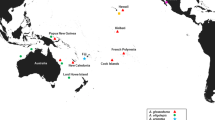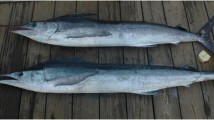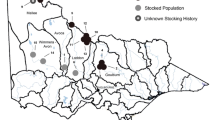Abstract
Population genetics has increasingly become an important tool for determining appropriate taxonomic units for managing species of conservation interest. Yelloweye rockfish (Sebastes ruberrimus), canary rockfish (S. pinniger) and bocaccio (S. paucispinis) in the inland waterways of Puget Sound (PS), WA, USA were listed under the U.S. Endangered Species Act (ESA) in 2010. These listings relied heavily on evidence from other species that these populations were ‘discrete’ taxonomic units because little information was available for these species in PS. To fill this data gap, we collaborated with recreational fishing communities in PS to collect tissue samples and used population genetics analyses to determine whether samples from PS were genetically differentiated from samples collected from the outer coasts of the U.S. and Canada. Multiple analyses using restriction-site associated DNA sequencing data showed that yelloweye rockfish in PS and British Columbia, Canada were genetically different from coastal populations, while canary rockfish showed no genetic differentiation. These results support hypotheses that the genetic connectivity of rockfish populations is based on interactions between life-history characteristics and oceanographic conditions. These data also support the ESA designation status and the expansion of protected geographical boundaries for yelloweye rockfish but also suggest canary rockfish in PS are not a ‘discrete’ population and may not meet the first criterion of the ESA, as initially assumed. Collaboration among agencies and fishing communities, and cost-efficient genetic analyses provided a framework for collecting and analyzing data essential to the conservation and management of threatened and endangered species.





Similar content being viewed by others
References
Alford MH, MacCready P (2014) Flow and mixing in Juan de Fuca Canyon, Washington. Geophys Res Lett 41:1608–1615
Babson AL, Kawase A, MacCready P (2006) Seasonal and interannual variability in the circulation of Puget Sound, Washington: a box model study. Atmos Ocean 44:29–45
Banas NS, Conway-Cranos L, Sutherland DA, MacCready P, Kiffney P, Plummer M (2015) Patterns of river influence and connectivity among subbasins of Puget Sound, with application to bacterial and nutrient loading. Estuaries Coasts 38:735–753
Benjamini Y, Hochberg Y (1995) Controlling the false discovery rate - a practical and powerful approach to multiple testing. J R Stat Soc Ser B 57:289–300
Black BA, Boehlert GW, Yoklavich MM (2008) Establishing climate-growth relationships for yelloweye rockfish (Sebastes ruberrimus) in the northeast Pacific using a dendrochronological approach. Fish Oceanogr 17:368–379
Bradburn MJ, Keller A, Horness BH (2011) The 2003 to 2008 U.S. West Coast bottom trawl surveys of groundfish resources off Washington, Oregon, and California: estimates of distribution, abundance, length, and age composition. U.S. Dept. of Commerce, NOAA Tech. Memo., NMFS-NWFSC-114
Buonaccorsi VP, Kimbrell CA, Lynn EA, Vetter RD (2002) Population structure of copper rockfish (Sebastes caurinus) reflects postglacial colonization and contemporary patterns of larval dispersal. Can J Fish Aquat Sci 59:1374–1384
Buonaccorsi VP, Westerman M, Stannard J, Kimbrell C, Lynn E, Vetter RD (2004) Molecular genetic structure suggests limited larval dispersal in grass rockfish, Sebastes rastrelliger. Mar Biol 145:779–788
Buonaccorsi VP, Kimbrell CA, Lynn EA, Vetter RD (2005) Limited realized dispersal and introgressive hybridization influence genetic structure and conservation strategies for brown rockfish, Sebastes auriculatus. Conserv Genet 6:697–713
Burford MO (2009) Demographic history, geographical distribution and reproductive isolation of distinct lineages of blue rockfish (Sebastes mystinus), a marine fish with a high dispersal potential. J Evol Biol 22:1471–1486
Catchen JA, Hohenlohe P, Bassham S, Amores A, Cresko W (2013) Stacks: an analysis toolset for population genomics. Mol Ecol 22:3124–3140
Coombs CI (1978) Reef fishes near Depoe Bay, Oregon: movement and the recreational fishery. MS Thesis, Oregon State University
Cope JM (2004) Population genetics and phylogeography of the blue rockfish (Sebastes mystinus) from Washington to California. Can J Fish Aquat Sci 61:332–342
COSEWIC (2008) COSEWIC assessment and status report on the Yelloweye Rockfish Sebastes ruberrimus, Pacific Ocean inside waters population and Pacific Ocean outside waters population, in Canada. Committee on the Status of Endangered Wildlife in Canada, Ottawa
Cowen RK, Gawarkiewic G, Pineda J, Thorrold SR, Werner FE (2007) Population connectivity in marine systems: an overview. Oceanography 20:14–21
Danecek P, Auton A, Abecasis G, Albers CA, Banks E, DePristo MA, Handsaker RE, Lunter G, Marth GT, Sherry ST, McVean G, Durbin R, Genomes Project Analysis G (2011) The variant call format and VCFtools. Bioinformatics 27:2156–2158
DFO (2006) A harvest strategy compliant with a precautionary approach. p. 7. DFO Can Sci Advis Sec Sci Advis Rep
Doremus H (1997) Listing decisions under the Endangered Species Act: why better science isn’t always better policy. Wash Univ Law Q 75:1029–1153
Drake JS, Berntson EA, Gustafson RG, Holmes EE, Levin PS, Tolimieri N, Waples RS, Sogard SM, Williams GD, Cope JM (2010) Status review of five rockfish species in Puget Sound, Washington: Bocaccio (Sebastes paucispinis), canary rockfish (S. pinniger), yelloweye rockfish (S. ruberrimus), greenstriped rockfish (S. elongatus), and redstripe rockfish (S. proriger). US Department of Commerce, National Oceanic and Atmospheric Administration, National Marine Fisheries Service
Earl DA, Vonholdt BM (2012) STRUCTURE HARVESTER: a website and program for visualizing STRUCTURE output and implementing the Evanno method. Conserv Genet Resour 4:359–361
Engie K, Klinger T (2007) Modeling passive dispersal through a large estuarine system to evaluate marine reserve network connections. Estuaries Coasts 30:201–213
Evanno G, Regnaut S, Goudet J (2005) Detecting the number of clusters of individuals using the software STRUCTURE: a simulation study. Mol Ecol 14:2611–2620
Fallon SM (2007) Genetic data and the listing of species under the US Endangered Species Act. Conserv Biol 21:1186–1195
Galarza JA, Carreras-Carbonell J, Macpherson E, Pascual M, Roques S, Turner GF, Rico C (2009) The influence of oceanographic fronts and early-life-history traits on connectivity among littoral fish species. Proc Natl Acad Sci USA 106:1473–1478
Gharrett AJ, Matala AP, Peterson EL, Gray AK, Li Z, Heifetz J (2007) Distribution and population genetic structure of sibling rougheye rockfish species. In: Heifetz J, DiCosimo J, Gharrett AJ, Love MS, O’Connell VM, Stanley RD (eds) Biology, assessment, and management of North Pacific Rockfishes, 23rd Lowell Wakefield Fisheries Symposium. Alaska Sea Grant College Program, University of Alaska, Fairbanks, Anchorage, pp 121–140
Grüss A, Kaplan DM, Guénette S, Roberts CM, Botsford LW (2011) Consequences of adult and juvenile movement for marine protected areas. Biol Cons 144:692–702
Hannah RW, Rankin PS (2011) Site fidelity and movement of eight species of Pacific rockfish at a high-relief rocky reef on the Oregon coast. North Am J Fish Manag 31:483–494
Hernandez PA, Graham CH, Master LL, Albert DL (2006) The effect of sample size and species characteristics on performance of different species distribution modeling methods. Ecography 29:773–785
Hess JE, Vetter RD, Moran P (2011) A steep genetic cline in yellowtail rockfish, Sebastes flavidus, suggests regional isolation across the Cape Mendocino faunal break. Can J Fish Aquat Sci 68:89–104
Hubisz MJ, Falush D, Stephens M, Pritchard JK (2009) Inferring weak population structure with the assistance of sample group information. Mol Ecol Resour 9:1322–1332
Hyde JR, Vetter RD (2009) Population genetic structure in the redefined vermilion rockfish (Sebastes miniatus) indicates limited larval dispersal and reveals natural management units. Can J Fish Aquat Sci 66:1569–1581
Jasonowicz AJ, Goetz FW, Goetz GW, Nichols KM (2016) Love the one you’re with: genomic evidence of panmixia in the sablefish (Anoplopoma fimbria). Can J Fish Aquat Sci 74:377–387
Johansson ML, Banks MA, Glunt KD, Hassel-Finnegan HM, Buonaccorsi VP (2008) Influence of habitat discontinuity, geographical distance, and oceanography on fine-scale population genetic structure of copper rockfish (Sebastes caurinus). Mol Ecol 17:3051–3061
Johnson TR, van Densen WLT (2007) Benefits and organization of cooperative research for fisheries management. ICES J Mar Sci 64:834–840
Jombart T (2008) adegenet: a R package for the multivariate analysis of genetic markers. Bioinformatics 24:1403–1405
Kelly RP (2010) The use of population genetics in Endangered Species Act listing decisions. Ecol Law Q 37:1107–1158
Kelly RP, Levin PS, Lee KN (2017) Science, policy, and data-driven decisions in a data vacuum. Ecol Law Q 44:7–40
Kopelman NM, Mayzel J, Jakobsson M, Rosenberg NA, Mayrose I (2015) CLUMPAK: a program for identifying clustering modes and packaging population structure inferences across K. Mol Ecol Resour 15:1179–1191
Lamichhaney S, Barrio AM, Rafati N, Sundstrom G, Rubin CJ, Gilbert ER, Berglund J, Wetterbom A, Laikre L, Webster MT, Grabherr M, Ryman N, Andersson L (2012) Population-scale sequencing reveals genetic differentiation due to local adaptation in Atlantic herring. Proc Natl Acad Sci USA 109:19345–19350
Lea RN, McAllister RD, VenTresca DA (1999) Biological aspects of nearshore rockfishes of the genus Sebastes from central California: with notes on ecologically related sport fishes. State of California, The Resources Agency, Department of Fish and Game
Leis JM (2007) Behaviour as input for modelling dispersal of fish larvae: behaviour, biogeography, hydrodynamics, ontogeny, physiology and phylogeny meet hydrography. Mar Ecol Prog Ser 347:185–193
Levin PS, Holmes EE, Piner KR, Harvey CJ (2006) Shifts in a Pacific ocean fish assemblage: the potential influence of exploitation. Conserv Biol 20:1181–1190
Love MS, Yoklavich M, Thorsteinson L (2002) The rockfishes of the northeast Pacific. University of California Press, Berkeley
Lowell N, Kelly RP (2016) Evaluating agency use of “best available science” under the United States Endangered Species Act. Biol Conserv 196:53–59
Masson D (2002) Deep water renewal in the Strait of Georgia. Estuar Coast Shelf Sci 54:115–126
Miller MR, Dunham JP, Amores A, Cresko WA, Johnson EA (2007) Rapid and cost-effective polymorphism identification and genotyping using restriction site associated DNA (RAD) markers. Genome Res 17:240–248
Morgan LE, Botsford LW (1998) The influence of larval transport and retention on recruitment patterns and the design of harvest refugia for rockfish. In: Yoklavich MM (ed) Marine harvest refugia for West Coast rockfish: a workshop. NOAA-TM-NMFS-SWFSC-255, La Jolla, pp 41–49
NMFS (2010) Endangered and threatened wildlife and plants: threatened status for the Puget Sound/Georgia Basin distinct population segments of yelloweye and canary rockfish and endangered status for the Puget Sound/Georgia Basin distinct population segment of bocaccio rockfish. National Marine Fisheries Service, Federal Register 75 FR 22276
NMFS (2016) Draft Rockfish Recovery Plan: Puget Sound/Georgia Basin yelloweye rockfish (Sebastes ruberrimus) and bocaccio (Sebastes paucispinis). National Marine Fisheries Service. http://www.westcoast.fisheries.noaa.gov/protected_species/rockfish/rockfish_in_puget_sound.html. Accessed 13 Oct 2017
Palumbi SR (2003) Population genetics, demographic connectivity, and the design of marine reserves. Ecol Appl 13:S146-S158
Palumbi SR (2004) Marine reserves and ocean neighborhoods: the spatial scale of marine populations and their management. Annu Rev Environ Resour 29:31–68
Paradis E (2010) pegas: an R package for population genetics with an integrated-modular approach. Bioinformatics 26:419–420
Parker S, Berkeley S, Golden J, Gunderson D, Heifetz J, Hixon M, Larson R, Leaman B, Love M, Musick J, O’Connell V, Ralston S, Weeks H, Yoklavich M (2000) Management of Pacific rockfish. Fisheries 25:22–29
Pembleton LW, Cogan NO, Forster JW (2013) StAMPP: an R package for calculation of genetic differentiation and structure of mixed-ploidy level populations. Mol Ecol Resour 13:946–952
Petersen CH, Drake PT, Edwards CA, Ralston S (2010) A numerical study of inferred rockfish (Sebastes spp.) larval dispersal along the central California coast. Fish Oceanogr 19:21–41
Pritchard JK, Stephens M, Donnelly P (2000) Inference of population structure using multilocus genotype data. Genetics 155:945–959
Rocha-Olivares A, Vetter RD (1999) Effects of oceanographic circulation on the gene flow, genetic structure, and phylogeography of the rosethorn rockfish (Sebastes helvomaculatus). Can J Fish Aquat Sci 56:803–813
Rocha-Olivares A, Rosenblatt RH, Vetter RD (1999) Molecular evolution, systematics, and zoogeography of the rockfish subgenus Sebastomus (Sebastes, Scorpaenida) based on mitochondrial cytochrome b and control region sequences. Mol Phylogenet Evol 11:441–458
Rousset F (2008) GENEPOP’007: a complete re-implementation of the GENEPOP software for Windows and Linux. Mol Ecol Resour 8:103–106
Seeb LW (1998) Gene flow and introgression within and among three species of rockfishes, Sebastes auriculatus, S. caurinus, and S. maliger. J Hered 89:393–403
Siegle MR, Taylor EB, Miller KM, Withler RE, Yamanaka KL (2013) Subtle population genetic structure in Yelloweye Rockfish (Sebastes ruberrimus) is consistent with a major oceanographic division in British Columbia, Canada. PLoS ONE 8:e71083
Sponaugle S, Cowen RK, Shanks A, Morgan SG, Leis JM, Pineda JS, Boehlert GW, Kingsford MJ, Lindeman KC, Grimes C, Munro JL (2002) Predicting self-recruitment in marine populations: biophysical correlates and mechanisms. Bull Mar Sci 70:341–375
Sutherland DA, MacCready P, Banas NS, Smedstad LF (2011) A model study of the Salish Sea estuarine circulation. J Phys Oceanogr 41:1125–1143
Taylor IG (2011) Rebuilding analysis for yelloweye rockfish based on the 2011 update stock assessment. Pacific Fishery Management Council. https://www.pcouncil.org/wp-content/uploads/Yelloweye_2011_Rebuilding.pdf. Accessed 13 Oct 2017
Taylor IG, Wetzel C (2011) Status of the U.S. yelloweye rockfish resource in 2011 (update of 2009 assessment model). Northwest Fisheries Science Center, National Marine Fisheries Service, Seattle
Tear TH, Scott JM, Hayward PH, Griffith B (1995) Recovery plans and the Endangered Species Act: are criticisms supported by data? Conserv Biol 9:182–195
Thorson JT, Wetzel C (2016) The status of canary rockfish (Sebastes pinniger) in the California Current in 2015. Northwest Fisheries Science Center, National Marine Fisheries Service, Seattle
USFWS-NMFS (1996) Policy regarding the recognition of distinct vertebrate population segments under the Endangered Species Act. Fed Reg, 61(26):4721–4725
Vincent B, Dionne M, Kent MP, Lien S, Bernatchez L (2013) Landscape genomics in Atlantic salmon (Salmo salar): searching for gene-environment interactions driving local adaptation. Evolution 67:3469–3487
WDFW (2015) Washington Sport Fishing Rules. Washington Department of Fish and Wildlife. http://wdfw.wa.gov/fishing/regulations/. Accessed 29 Mar 2016
Weersing K, Toonen RJ (2009) Population genetics, larval dispersal, and connectivity in marine systems. Mar Ecol Prog Ser 393:1–12
Weir BS, Cockerham CC (1984) Estimating F-statistics for the analysis of population structure. Evolution 38:1358–1370
Williams GD, Levin PS, Palsson WA (2010) Rockfish in Puget Sound: an ecological history of exploitation. Mar Policy 34:1010–1020
Withler RE, Beacham TD, Schulze AD, Richards LJ, Miller KM (2001) Co-existing populations of Pacific ocean perch, Sebastes alutus in Queen Charlotte Sound, British Columbia. Mar Biol 139:1–12
Yamanaka KL, Lacko LC, Withler R, Grandin C, Lochead JK, Martin JC, Olsen N, Wallace SS (2006) A review of yelloweye rockfish Sebastes ruberrimus along the Pacific coast of Canada: biology, distribution and abundance trends. p 54. Canadian Science Advisory Secretariat Research Document
Yamanaka KL, McAllister MK, Olesiuk PF, Etienne M-P, Obradovich S, Haigh R (2012) Stock assessment for the inside population of yelloweye rockfish (Sebastes ruberrimus) in British Columbia, Canada for 2010. DFO Can Sci Advis Sec Res Doc
Yang J, Benyamin B, McEvoy BP, Gordon S, Henders AK, Nyholt DR, Madden PA, Heath AC, Martin NG, Montgomery GW, Goddard ME, Visscher PM (2010) Common SNPs explain a large proportion of the heritability for human height. Nat Genet 42:565–569
Acknowledgements
We thank captains J. Field, S. Kesling, M. Jamboretz, G. Krein, R. Jones, B. Rosson, C. Long, N. Kester, and T. Burlingame for their expertise in putting us on these rare fish; Puget Sound Anglers and the Kitsap Poggie Club for helping coordinate anglers for these trips, and the nearly 100 local anglers who helped collect these fish. We thank A. Hennings & J. Blaine for providing GPS coordinates of sightings of listed species from ROV surveys, K. Cooke, R. Withler and C. Gummer for logistical support in getting samples from the Department of Fisheries and Oceans, Canada, J. Harms from the Northwest Fisheries Science Center for sharing fin clip samples from coastal populations and M. Craig, J. Hyde and R. Vetter from the Southwest Fisheries Science Center for sharing fin clip samples from coastal bocaccio. Thanks to C. Do, G. Goetz, and T. Gosselin for assistance with analysis tools. We also thank the members of NOAA’s Biological Review Team who reviewed preliminary analyses of this work, and peer reviewers that provided comments previously on the five-year status review and the science presented in the proposal for the ESA delisting of canary rockfish. We also thank external reviewers and the editor for their comments. Samples were collected under ESA Section 10a permit #17062-3M. The National Oceanic & Atmospheric Administration’s National Cooperative Research Program provided funding for this research in 2014. The scientific results and conclusions, as well as any views or opinions expressed herein, are those of the authors and do not necessarily reflect the views of NOAA or the Department of Commerce.
Author information
Authors and Affiliations
Corresponding authors
Electronic supplementary material
Below is the link to the electronic supplementary material.
Rights and permissions
About this article
Cite this article
Andrews, K.S., Nichols, K.M., Elz, A. et al. Cooperative research sheds light on population structure and listing status of threatened and endangered rockfish species. Conserv Genet 19, 865–878 (2018). https://doi.org/10.1007/s10592-018-1060-0
Received:
Accepted:
Published:
Issue Date:
DOI: https://doi.org/10.1007/s10592-018-1060-0




